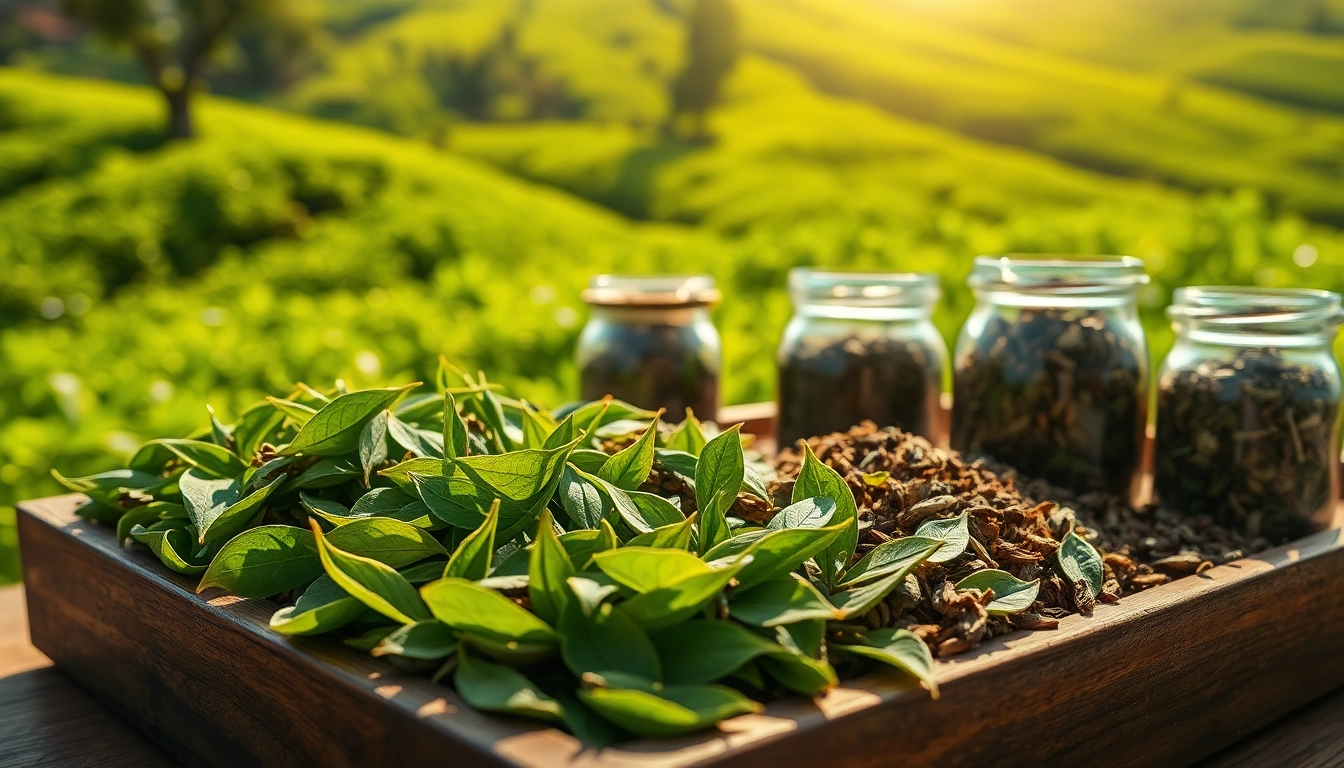Understanding Single Origin Tea
Single origin tea has gained immense popularity among tea aficionados and casual drinkers alike, thanks to its uniquely rich flavors and distinct characteristics rooted in specific growing regions. Unlike blended teas that combine leaves from various locations, single origin tea comes exclusively from one defined area, offering a glimpse into the terroir, tradition, and craftsmanship behind each brew. Importantly, this form of tea enhances the connection between the consumer and the source, making it a compelling choice for discerning tea drinkers. If you’re eager to explore the vivid world of tea, focusing on single origin tea could be your perfect introduction.
What is Single Origin Tea?
Single origin tea refers to tea harvested from a specific geographic location, often from a single estate or plantation. It has no additional flavorings or blends, allowing the intrinsic qualities of the tea leaves to shine through. Typically, the designation indicates that the leaves share characteristics influenced by various factors, such as climate, soil type, and cultivation methods unique to that region. By consuming single origin tea, one can experience the subtle variations that make each tea distinct.
Key Characteristics and Benefits
Single origin teas are often celebrated not just for their unique flavors, but also for their health benefits. Here are some notable characteristics:
- Distinct Flavor Profiles: Each region imparts its own signature taste to the tea, influenced by altitude, weather conditions, and soil composition.
- Transparency: Consumers often benefit from greater transparency regarding the growing practices and origins of their tea.
- Taste Consistency: Farmers typically maintain traditional cultivation and processing methods, ensuring quality and continuity in flavor from year to year.
- Health Benefits: These teas frequently maintain higher levels of antioxidants and other beneficial compounds as a result of careful handling and fewer additives.
How It Differs from Blended Teas
The primary distinction between single origin and blended teas lies in their composition. Blended teas mix leaves from various regions to create a consistent flavor profile. While this can offer a balanced taste, single origin teas are unique and emphasize individual characteristics tied to their specific locales. In essence:
- Unique Terroir: Single origin teas showcase unique flavors inherent to the geographic area, while blended teas generalize taste.
- Transparency: Single origin teas provide more information about sourcing and cultivation compared to many blends.
- Culinary Pairing: Single origin teas can offer more diverse and complex pairing options due to their distinct flavor profiles.
Exploring the Global Regions of Single Origin Tea
Top Regions Renowned for Single Origin Tea
Certain regions across the globe are particularly famous for their unique contributions to the world of single origin tea:
- Darjeeling (India): Often referred to as the “Champagne of teas,” Darjeeling is known for its delicate, floral notes and muscatel flavor.
- Assam (India): Renowned for robust black teas with malty sweetness and rich body, Assam is a staple in many tea blends.
- Uji (Japan): Famous for its high-quality green teas, Uji boasts finely processed leaves resulting in deep umami flavors.
- Nilgiri (India): With its aromatic and fragrant profile, Nilgiri teas are smooth and often characterized by floral hints.
- Keemun (China): Known for its rich and complex flavors, Keemun black tea possesses a hint of smokiness.
Flavor Profiles by Region
Understanding flavor profiles allows tea enthusiasts to select their favorite types effectively. Here is a look at representative flavors from key single origin tea regions:
| Region | Primary Flavors | Tea Type |
|---|---|---|
| Darjeeling | Floral, Muscatel, Mildly Astringent | Black |
| Assam | Rich, Malty, Bold | Black |
| Uji | Vegetal, Umami, Sweet | Green |
| Nilgiri | Fragrant, Smooth, Bright | Black |
| Keemun | Fruity, Wine-like, Smoky | Black |
Climate and Terroir Influences
The attributes of single origin tea are significantly influenced by the climate and terroir of the region in which they are grown. Climate conditions such as rainfall, temperature fluctuations, and sunlight play a crucial role in developing the tea’s flavor profiles. Additionally, soil composition, elevation, and proximity to water bodies all impact the cultivation of the tea plants and the eventual flavor and aroma of the beverage:
- Soil: Loamy and fertile soils, rich in organic matter, produce superior quality tea leaves.
- Elevation: Higher elevations can slow down the rate of leaf growth, producing teas with more complex flavors.
- Climate: Ideal temperatures and adequate rainfall are critical in ensuring healthy tea plant growth.
Selecting Quality Single Origin Teas
How to Identify Quality Tea Leaves
When selecting single origin tea, several key indicators can help you identify quality leaves:
- Appearance: High-quality leaves are usually whole and well-formed, with vibrant color and sheen. Avoid dusty or broken leaves.
- Uniformity: Consistent size and color indicate careful processing and selection.
- Aroma: Freshly dried leaves should have a potent and pleasant aroma; a faint or nonexistent smell may indicate age or poor storage.
Understanding Packaging and Labeling
Proper packaging is essential for maintaining the quality of tea. When examining single origin tea, consider the following:
- Sealed Bags: Look for vacuum-sealed packaging that protects the leaves from air exposure and moisture.
- Label Details: Quality teas often come with detailed labeling that includes information on the origin, growing conditions, and harvest date.
- Organic Certification: If you prefer organic options, ensure the tea is certified organic and has the appropriate display of certification on the packaging.
Ethical Sourcing Practices
Ethical sourcing enhances the value of single origin tea and supports sustainable practices. Consider choosing brands and producers that practice:
- Fair Trade: Ensure the farmers receive fair wages and work in humane conditions.
- Organic Practices: Support producers who avoid harmful pesticides and employ environmentally responsible farming techniques.
- Transparent Supply Chains: Understanding where your tea comes from encourages sustainable farming practices and responsible consumption.
Brewing Techniques for Single Origin Tea
Optimal Brewing Methods
Brewing single origin tea requires a precise approach that respects its unique characteristics. The following steps provide essential guidance for preparing the perfect cup:
- Water Quality: Start with fresh, filtered water, as minerals and impurities can affect the tea’s flavor.
- Temperature: Use the recommended water temperature for the specific type of tea. Generally, white and green teas require cooler temperatures, while black and herbal teas can withstand boiling.
- Steeping Time: Adhere to suggested steeping times to prevent over-extraction, which can lead to bitterness.
- Tea-to-Water Ratio: Typically, one teaspoon of tea leaves per cup is a good starting point, but adjust based on personal preferences and specific tea recommendations.
Equipment Essentials for Perfect Tea
Investing in proper equipment can greatly enhance your tea brewing experience. Essential items include:
- Teapot or Infuser: Choose a good-quality teapot or infuser that allows leaves to expand freely and ensures optimal flavor extraction.
- Tea Kettle: A kettle with temperature control can help achieve precision in water temperature.
- Tea Scale: For consistency, a scale can help accurately measure tea leaves and water.
Tasting Notes and Pairings
Once brewed, savoring single origin tea opens up a world of tasting notes and pairings suited to enhance its delightful characteristics:
- Darjeeling: Great with light snacks, scones, or citrus desserts.
- Assam: Pairs well with hearty dishes, chocolate desserts, or robust breakfast items.
- Uji: Complements sushi, sashimi, or light salads due to its umami qualities.
The Growing Popularity of Single Origin Tea
Trends in Tea Consumption
In recent years, a notable trend in tea consumption has emerged. Consumers are increasingly aware and interested in the origins and methodologies behind their beverages. The emergence of single origin teas highlights this shift, as drinkers seek authentic flavors and sustainable practices. Reports indicate a marked increase in premiums placed on traceable and ethically sourced products, leading to an expansion of the specialty tea market.
The Rise of Specialty Tea Shops
Specialty tea shops are becoming more prevalent in urban areas, catering to a new wave of tea enthusiasts eager to explore single origin offerings. Many of these shops focus on small-batch teas and often host tastings or educational events to further engage their customers. This not only elevates the appreciation of single origin tea but also fosters a community around shared knowledge and experiences.
Feedback from Tea Enthusiasts
Feedback from consumers reveals a significant admiration for the quality and transparency of single origin teas. Enthusiasts appreciate the storytelling aspect of these teas, as they engage with the history, methodology, and people behind each cup. Online tea forums and social media groups dedicated to tea discussions have made it easier for consumers to share their experiences and recommendations, contributing to an overall heightened interest in single origin options.


